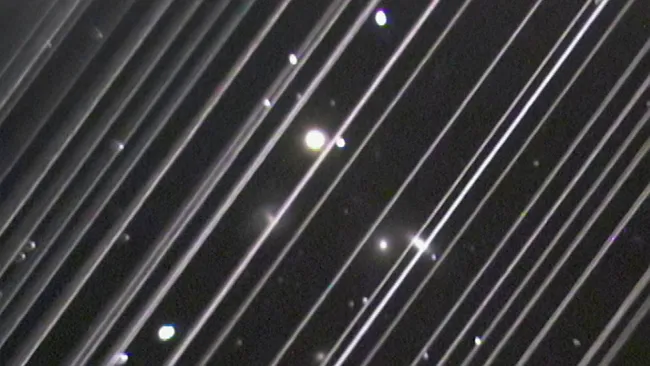SpaceX’s Starlink network has revolutionized global internet access, but it’s also creating new challenges for radio astronomy. A recent study from Curtin University, which analyzed 76 million images from a prototype of the Square Kilometre Array (SKA) telescope, shows that Starlink satellites are interfering with radio observations.
In some datasets, up to 30% of the images were affected by emissions from Starlink satellites. Using the Engineering Development Array 2 (EDA2) in Western Australia, researchers detected 112,534 emissions from 1,806 individual Starlink satellites. Many of these signals were unintentional, leaking from satellite electronics into frequency bands specifically reserved for astronomy.
The study found that 703 satellites emitted signals at 150.78 MHz, a frequency protected by the International Telecommunication Union (ITU) for radio astronomy. Another 13 satellites were detected in the 73.00–74.60 MHz protected band.
“Starlink is the most immediate and frequent source of potential interference for radio astronomy: it launched 477 satellites during this study’s four-month data collection period alone,” said Dylan Grigg, the study’s lead author and a Ph.D. candidate at Curtin University, in a statement. The interference doesn’t come from the satellites’ communication systems but from other components such as propulsion and avionics, which makes it more difficult to control.

As of September 2024, Starlink has over 7,000 satellites in orbit, making it the largest satellite network around Earth. SpaceX adds about 40 new satellites each week. Newer models, like the v2-mini satellites, give off stronger radio signals than earlier ones. That’s a growing problem for astronomers who rely on quiet radio frequencies to detect faint signals from distant galaxies and nebulae.
The Curtin University study also found that Starlink satellites reflect FM radio signals from the ground. At 99.70 MHz, four satellites were seen bouncing signals from a 10 kW transmitter in Geraldton, Australia, located 300 kilometers from the telescope. These reflections were strongest when the satellites were closest to the transmitter, and their position in orbit may be making this worse.
Steven Tingay, executive director of the Curtin Institute of Radio Astronomy, pointed out that Starlink isn’t breaking any rules. “It is important to note that Starlink is not violating current regulations, so is doing nothing wrong. Discussions we have had with SpaceX on the topic have been constructive,” he said. The team released its data publicly in the hope that it will help shape future rules.
The effect on astronomy is clear. Radio telescopes like SKA-Low are built to pick up signals as faint as 1 millijansky. But Starlink’s emissions averaged 93 jansky per beam in the study, easily drowning out the weaker signals researchers are trying to measure.
An earlier study conducted by the Netherlands Institute for Radio Astronomy (ASTRON), using the LOFAR telescope in the Netherlands, found similar issues in 2023. That work covered the 10–188 MHz range. The Curtin team expanded on that, tracking emissions up to 235 MHz and finding changing signal patterns that may help trace the source of the noise, though the exact cause is still being looked into.
Astronomers are now urging updates to existing rules to help limit these kinds of emissions. For now, the challenge is how to keep both global internet access and sky observations working side by side.
The study was published in the Astronomy & Astrophysics journal.

